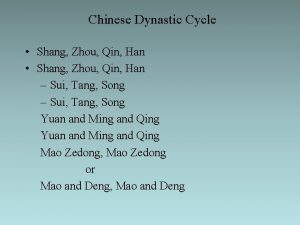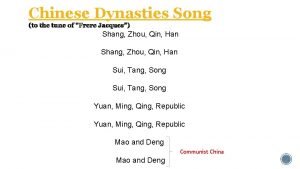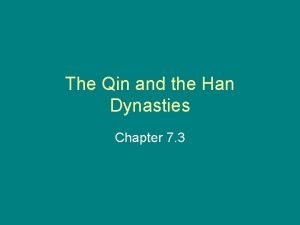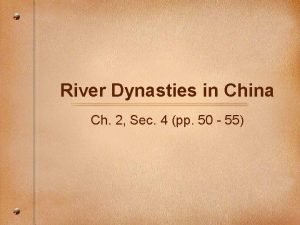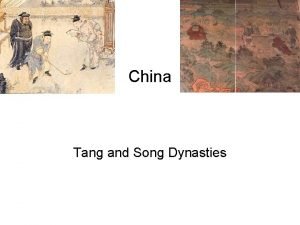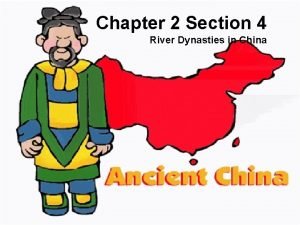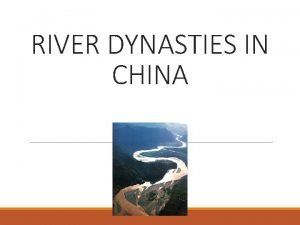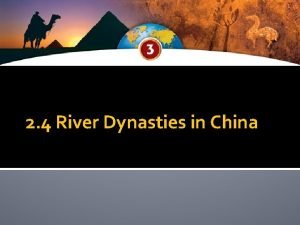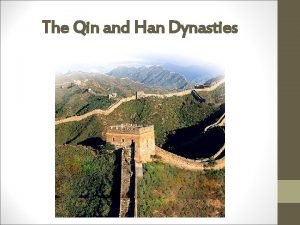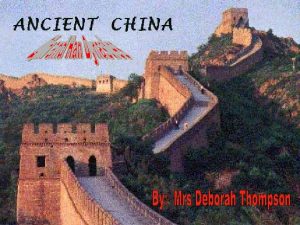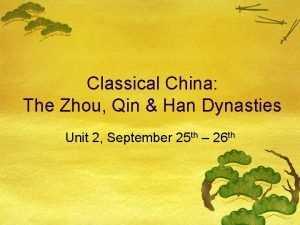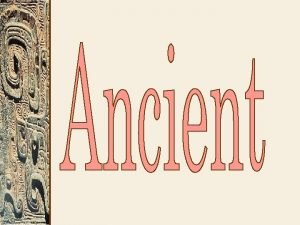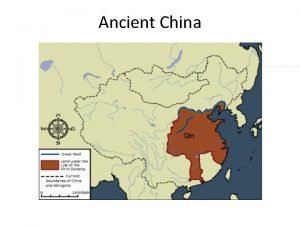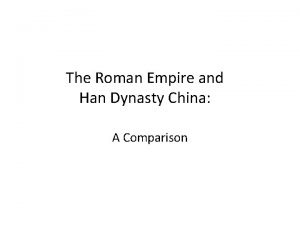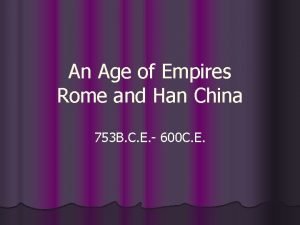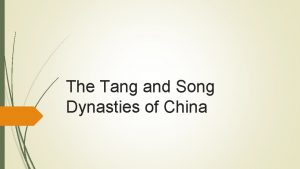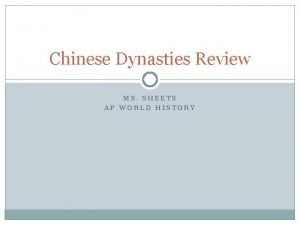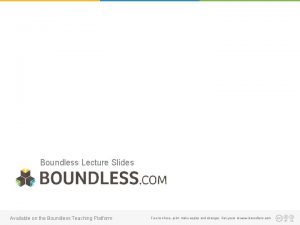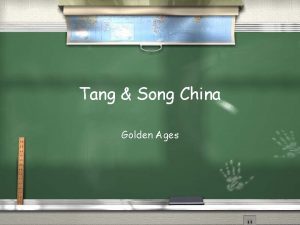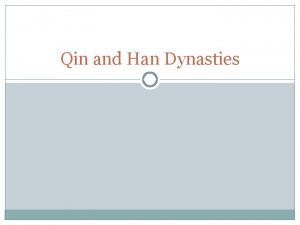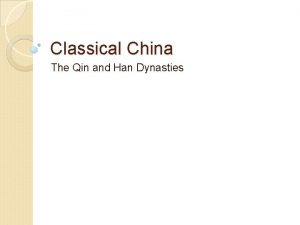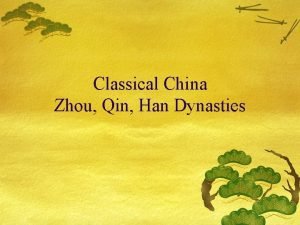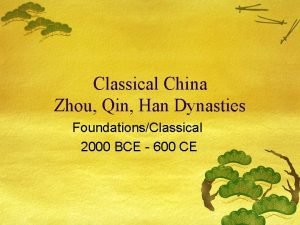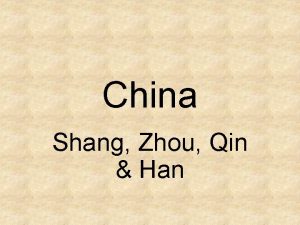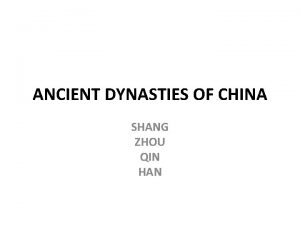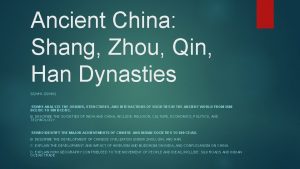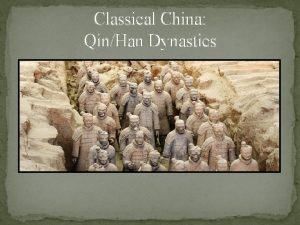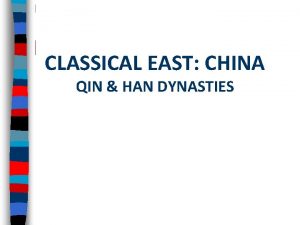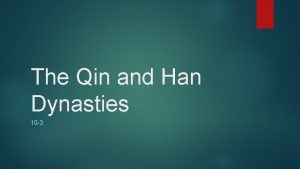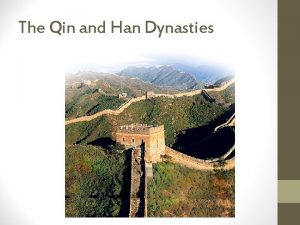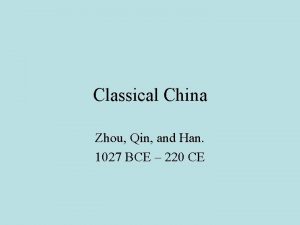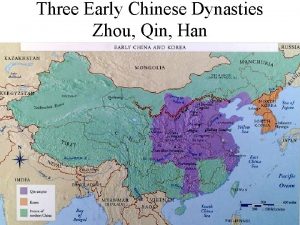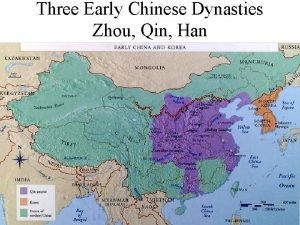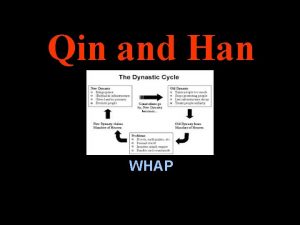Classical China The Zhou Qin Han Dynasties Unit




























- Slides: 28

Classical China: The Zhou, Qin & Han Dynasties Unit 2, September 25 th – 26 th

From Ancient to Classical Civilizations £Most ancient river valley civilizations declined after 1200 BC £The classical civilizations, which began to emerge around 1000 BC were different from their predecessors, as they grew noticeably larger through trade and conquest £China was the first and the largest of the classical civilizations

£ Chinese civilization originally developed along the Yellow River in relative isolation £ By around 1500 BC, a line of kings called The Shang ruled over the Yellow River valley. They began the dynastic cycle that would endure until the 20 th century. £ Chinese Dynastic Cycle: 1. 2. 3. 4. New family establishes dynasty (new institutions, economy) Dynasty grows weak Internal rebellions and/or external rebellions New dynasty emerges

Chinese Dynasties followed the Mandate of Heaven – belief that the gods transferred their power to a specific family and that Emperors were sons of Heaven


Zhou Dynasty (1027 - 250 BC) £ The Zhou emerged in 1027 BC and became the longest lasting Dynasty and first classical era dynasty in China £ They justified their rule, by claiming that the Shang had forfeited the “Mandate of Heaven” due to their misrule £ Mandate of Heaven remained a key justification for Chinese imperial rule in all subsequent dynasties (think Divine Right). £ They promoted linguistic unity via a standard spoken language – Mandarin Chinese. This created the largest single group of people speaking the same language in the world at that time.

£ Featured decentralized politics but important cultural innovations including the use of cast iron (stronger weapons & farming tools), invented the crossbow and invented silk cloth £ They established a system of currency, using bronze and coins were shaped like a spade £ They banned human sacrifice & formalized religion by focusing on Ancestor worship and focusing on harmony £ Economically agriculture dominated – Wheat in the North and Rice in the South

Chinese Feudalism £ China’s feudal period occurred during the Zhou Dynasty ¤ Rulers gave land to their supporters in exchange for defense ¤ Regional rulers owned the land were given absolute authority over it ¤ Peasants could not own land, but worked the land of the nobles £ This form of government worked well for several hundred years. However, overtime the king slowly became less powerful, while the nobleman grew in power.

Chinese feudal system developed under the Zhou dynasty King Grants use of land to nobles in exchange for loyalty Nobles Give loyalty and armies to the king Peasants Work the land for the nobles in exchange for shelter, protection, and food Merchants Lower status than peasants because riches come from other’s work

Zhou Dynasty Overthrown £ In 771 B. C. while fighting against a rebellion, the Zhou armies suffered a terrible defeat. As a result, the Zhou Dynasty lost even more power to the noblemen. They managed to hang on to power for another 500 years. Then in 256 B. C. E. the Zhou Dynasty was finally overthrown. £ The end of the dynasty led to the development of Confucianism and other philosophies

£ The breakdown of the Zhou dynasty’s ability to control its vassals in the 8 th c B. C. E. led to a long period of political conflict (i. e. landowning aristocrats solidified their own power base and disregarded the central govt. ) £ Period of Warring States from 402 BCE - 201 BCE ¤ Competing interests of landowning class and ruling class cause political turmoil ¤ Landowners raise their own militaries - origins of regional warlords ¤ No political unity - China is exceptionally weak ¤ Cultural innovations survive

Confucianism £ Confucius was a Chinese teacher, editor, politician, and philosopher £ Goal was to restore social order, harmony and good government to China £ Ethical systems based on relationships and personal virtue – Code of Politeness £ Emphasized family ¤Filial piety - respect for parents and elders is necessary for order £ Early Zhou Dynasty was seen as the perfect society ¤ Inferiors devoted to service ¤ Superiors looked after dependents

£ Five Basic Relationships in Society ¤Ruler/Subject ¤Father/Son ¤Husband/Wife ¤Older Brother/Younger Brother ¤Friend/Friend £ Chinese gentleman – education and moral standards; birth status not important £ Bureaucracy - those who help run government ¤Courteous, precise, generous, just/fair

Daoism/Taoism £ Founded by Lao Tze with the goal to create harmony by finding natural balance £ Believed human actions are not important £ Most important part of society is natural order of things ¤The Dao (The Way) – guides all things £ Search for knowledge and understanding of nature £ To understand nothing, it is best to do nothing, to observe nature ¤Nature is not jealous or power hungry – Yin and Yang ¤Does not argue about right or wrong, good or bad ¤ One needs humility – low view of one’s importance

Legalism £ Practical, political reaction to Confucianism ¤Founded by Han Feizi in the 3 rd century BCE ¤Goal was the create peace and order through strict laws because people are selfish and cannot be trusted £ Focused on the adherence to law £ Powerful and efficient government is key to restoring order ¥Laws will end civil war and restore harmony ¥Rewards to good subjects and punish disobedient ¥Rulers must control ideas and actions of people ¥Favored by Shi Huangdi during Qin dynasty


Qin Dynasty(221 - 207 BC) £ Emerged out of the end of Zhou Dynasty and period of Warring States £ By 221 BCE, warrior Shi Huangdi brought an end to the years of civil strife and disunity, thus ushering in the Qin Dynasty. £ His goals were to unify and expand China, thus restoring order £ Shi Huangdi used brutality and force to accomplish his goals and he controlled all aspects of society, including using military control in each region so noblemen could not rebel again his.

£ Shi Huangdi introduced standard weights and measures, eliminated the practice of slavery, created a uniform writing system, and sponsored agricultural projects like irrigation £ He also instituted high taxes, established a strict set of written laws that were recognized throughout China, and imposed censorship to control information, included banning Confucianism – he adopted legalism with harsh punishments

Qin Building Projects £ To make China the most glorious nation on Earth, Qin needed labor. £ He used the peasants, forcing them to work under slave conditions, so that he could build roads, bridges, canals, buildings, and his most famous building project of all, the Great Wall of China. £ The Great Wall of China extended over 4, 000 miles

Fall of the Qin Dynasty £ Shi Huangdi was extremely paranoid and killed off suspected enemies (nobles, intellectuals, warlords), vanquished all his rivals and founded a new imperial court £ Shi Huangdi died in 210 BCE and his death was followed by peasant revolts to determine his successor £ Shi Huangdi proved to be a tyrant, so his dynasty ended with his death and he is buried with an army of terra cotta soldiers and horses


The Han Dynasty (202 BC – 221 AD) £ After Shi Huangdi’s death, Liu Bang, a peasant led a revolt, giving rise to the Han dynasty £ During the next 400 years, the Han Dynasty would rule China and become one of the wealthiest and most powerful nations £ Because of its location amidst high mountains and surrounded by water, China was isolated from much of the rest of the world while they flourished

£ The Han Dynasty replaced legalism with Confucianism, introduced the civil service examination (process of selecting government officials based on merit rather than noble birth), and limited the power of the emperor through checks & balances £ Emperor Wu, who ruled from 141 – 87 BC was the greatest of the Han emperors ¤ He helped expand the empire ¤ He created the Silk Roads – a series of trade routes linking China, the Mediterranean cultures and the Roman Empire


£Peace within the Han Dynasty brought great prosperity £Buddhism was introduced, paper was invented and Confucius was established as a God £Similarly to Rome, the government sponsored public works projects, including complex irrigation and canal systems £They were not a highly militaristic society

Decline of the Han £ Beginning in 221 AD, the Han dynasty was overturned by nomadic raiders, the Huns £ Warlords began to control China, with no centralized government due to corruption and weak leaders £ Buddhism becomes popular as Confucianism fails

Chinese Society £ The strength of their agriculture allowed China to carry about 1/5 of the total human population from the last centuries BC to the present day. £ 3 main social groups: ¤ Landowning aristocracy (educated bureaucrats or mandarins) ¤ Laboring masses (peasant farmers, urban artisans) ¤ Mean people (unskilled laborers, performing artists). Required to wear green scarves for identification. Punished for crimes more harshly. £ According to Confucianism, men were superior to women, old superior to young, etc. £ Courts didn’t prosecute parents who injured or killed children, but would punish a disobedient child ¤ “There are no wrongdoing parents. ”

£ Trade became important during Zhou & Han Dynasties – they focused on luxury items like silk and porcelain, which became highly valued £ Confucianism emphasized learning and political service led to scorn if your life was devoted to moneymaking. Therefore, wealthy merchants had low prestige in social hierarchy £ Chinese civilization evolved without outside influence – they saw outsiders as barbarians ¤ Exception – Buddhism £ Chinese inventions like paper and the compass were disseminated over Eurasia and Africa, leading to new technological advancements in those regions
 Dynastic cycle
Dynastic cycle Shang zhou qin han
Shang zhou qin han Qin han
Qin han Chapter 2 section 4: river dynasties in china answer key
Chapter 2 section 4: river dynasties in china answer key Tang and song dynasty venn diagram
Tang and song dynasty venn diagram What was the dynastic cycle
What was the dynastic cycle River dynasties in china
River dynasties in china How did the sui and tang dynasties reunite china
How did the sui and tang dynasties reunite china River dynasties in china
River dynasties in china China qin dynasty map
China qin dynasty map Qin map
Qin map Ancient china zhou dynasty
Ancient china zhou dynasty China zhou dynasty
China zhou dynasty China zhou dynasty
China zhou dynasty Zhou dynasty wars
Zhou dynasty wars The han restore unity to china
The han restore unity to china Spice t
Spice t Han dynasty china and imperial rome
Han dynasty china and imperial rome Rome and han china
Rome and han china Sui tang song
Sui tang song Dynasties of delhi sultanate
Dynasties of delhi sultanate Water clocks han dynasty
Water clocks han dynasty Chinese dynasties
Chinese dynasties Sui dynasty contributions
Sui dynasty contributions Song
Song Ap world history chinese dynasties
Ap world history chinese dynasties Chinese dynasties
Chinese dynasties Srivijaya empire ap world history
Srivijaya empire ap world history Golden age of tang and song dynasties
Golden age of tang and song dynasties
